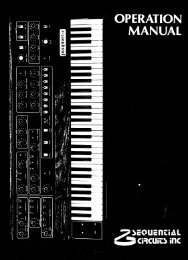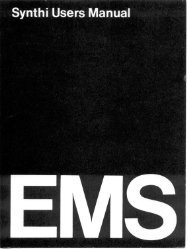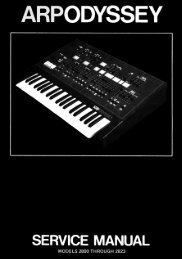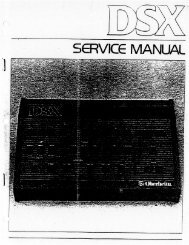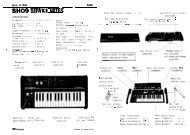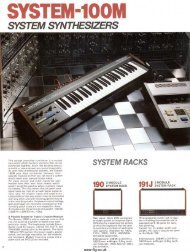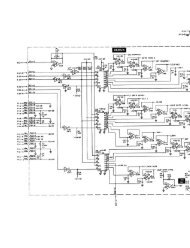ARP2600 - Fundamentals of Music Technology - Cyborgstudio.com
ARP2600 - Fundamentals of Music Technology - Cyborgstudio.com
ARP2600 - Fundamentals of Music Technology - Cyborgstudio.com
You also want an ePaper? Increase the reach of your titles
YUMPU automatically turns print PDFs into web optimized ePapers that Google loves.
SUSTAIN RELEASEVOLTAGE TIMEDECAYTIMEATTACKTIMELEFTOUTPUTINITIAL GAININITIAL FILTER FREQUENCYINITIAL OSCILLATOR FREQUENCYINITIAL OSCILLATOR FREQUENCYINITIAL OSCILLATOR FREQUENCYPAN10 100 1KHz 10KHz10 100 1KHz 10KHz.03 .3 3.0 3010 100 1KHz 10KHz.03 .3 3.0 3010 100 1KHz 10KHz.03 .3 3.0 30RANGE112FINE TUNEX1000X100X10INFINE TUNELEFTINPUTFINE TUNEFINE TUNE0GAIN MAXRESONANCEMIN MAXRIGHTINPUTPULSE WIDTH10% 50% 90%PULSE WIDTH10% 50% 90%PREAMPLIFIERSAWTOOTHTRIANGLE SAWTOOTHSAWTOOTHOUTMIXERVOLTAGECONTROLLEDAMPLIFIERA D S ROUTVOLTAGECONTROLLEDFILTER/RESONATORVCFOUTPUTSOUTPUTENVELOPETRANSIENTGENERATORVOLTAGECONTROLLEDOSCILLATORVCO-3OUTPUTSVOLTAGECONTROLLEDOSCILLATORVCO-2OUTPUTSVOLTAGECONTROLLEDOSCILLATORVCO-1RELEASETIMEOUTPUTMANUALSTARTATTACKOUTPUT DECAYSUSTAINRELEASEATTACKTIME2PULSEPULSESINESQUAREOUTRINGMODULATORENVELOPEFOLLOWERPWMREVERB-ERATORATTACKRELEASE ENVELOPETRANSIENTOUTGENERATORAUDIOKBD ONKBD OFFAUDIOKBD ONKBD OFFAUDIOKBD ONKBD OFFKEYBOARDGATE/TRIGL FL FL FCONTROLAUDIOLINEAR EXP’LAUDIOA RCONTROLAUDIOFM CONTROLPULSE WIDTHMODULATIONFM CONTROLFM CONTROLAUDIOTRIGGATEDCMIXEROUTVCAVCFRINGMOD AR ADSRVCFS/HGATE3VCOKBDCV ADSRVCO VCO VCO1 2NOISEGENRINGMODVCO2KBD NOISECV GEN ADSRVCO1NOISEGENKBD S/HCV OUT ADSRVCO2KBD S/HCV OUT ADSRVCO2VCO1PRE-AMPPOWERSAMPLE & HOLD1-10VRIGHTSPEAKER2NOISE GENERATORALEFTSPEAKERKBDCVELECTRONICSWITCHNOISEGEN3MAXKBDCV4WHITEOUTARP MODEL 2600BINTCLOCKOUTINVERTER5+10VS/HOUT6INVERTERCENV FOLLNOISEGENOUTPUTPINKMULTIPLESTEREOPHONESLEVEL RATE INTERNALCLOCKEXTCLOCKIN7 LAGLOWFREQMINEXT.VIBRATOINLFOdisappointed or confused looking here. None <strong>of</strong> the sliders are marked, indicating that all <strong>of</strong> them are in the zeroedposition, and what is more, no patch cables are connected here. The VCA is not involved in this patch. Why wouldthe VCA’s level be up in the mixer then? Two possibilities present themselves here. If this were a real-world patchsheet, the synthesist had probably just left that slider in place from an earlier experiment and hadn’t taken time t<strong>of</strong>ully trace out every part <strong>of</strong> the patch before notating it. The second possibility is that in an academic situation,teachers love to insert the occasional ‘dead end’ on a patch on tests and quizzes.PORTAMENTOFOOTSWITCHLFO LFODELAYUPPERVOICEINTERVALLATCHKYBDSINGLEAUTOMULTIPLESo, the VCA had no sound <strong>com</strong>ing into it, and thus has no sound <strong>com</strong>ing out <strong>of</strong> it. One must then turn to the VCF,since all <strong>of</strong> the sound must be <strong>com</strong>ing through it. Indeed, there are some things to look for here. VCO-2 and 3 havetheir levels fully raised, and the ring modulator’s level is raised a little. So any sound that is going to be heard mustbe <strong>com</strong>ing from one <strong>of</strong> these three places. Notice that a patch cord has been inserted into the VCO-3 audio input onthe VCF. This cord <strong>com</strong>es from VCO-3, though, so it doesn’t matter. As a final check before <strong>com</strong>pleting the firststep, check to see that no other sources have been plugged into the ring modulator. Close inspection shows thatVCO-3 has been connected to the ring modulator in place <strong>of</strong> VCO-1.VIBRATODEPTHVIBRATODELAYLFOSPEEDREPEATTRIGGERMODEON2 OCTAVESUPOFFMOMEN.2 OCTAVESDOWNPITCH BENDPORTAMENTOTRANSPOSEFigure 14-3: The FM specialpatch diagrammed




